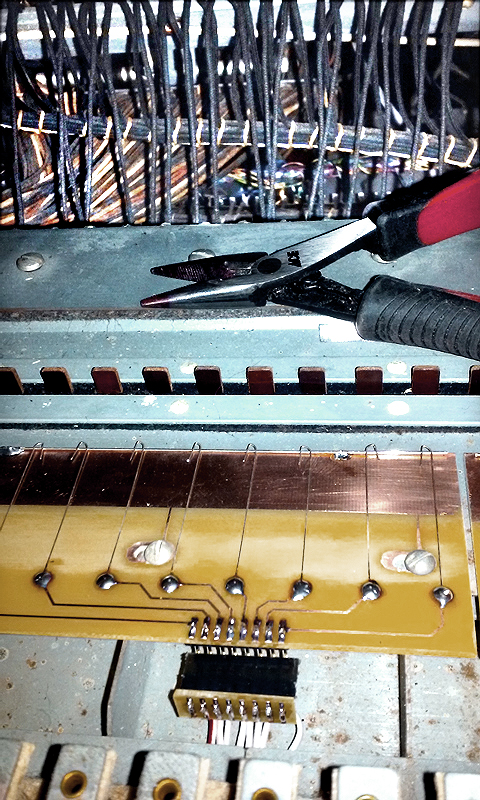String Bass Effect and MIDI on a C2
North Suburban HAMMOND ORGAN Service
Now you have seen what is involved to upgrade a typical older Hammond organ. This is still a work in progress, in that at the present, regarding the MIDI, I must make my tonal changes on the MIDI sound source, that is, the Casio keyboard. My next improvement will be to devise some type of control panel that can be a part of the C2 Hammond so that I can make my registration changes much more easily without having to look and reach away from the console in order to do this. Also, my immediate next improvement will be the variable speed drive for the vibrato scanner. There are many small DC motors available with a speed range between 1000 and 2000 RPMs that will operate from a 10 to 20 volt DC supply. Many of these motors use permanent magnets for the field assembly which is good, because that should give me a constant strength magnetic field; then the speed will vary with the armature current which can be supplied by a small adjustable DC power supply that can easily be incorporated inside the console. Also, it does not take much torque to spin the rotor of a Hammond vibrato scanner. The only major forces to contend with are bearing friction and windage, both of which, considering the relatively low RPM range of a scanner rotor (340 to 400 RPM) are very small forces to contend with.
Figure 15. Here is another good look at one of the new MIDI key contact printed circuit cards. Right in front you can see the plug and socket where eight of the 16 wires of a particular ribbon cable connect to the card. This makes it easy to remove a card if it should ever be necessary. You can also see how the individual contacts touch the common busbar. In this picture, the contacts all lie flat and touch the busbar as I have not yet individually adjusted them which I did note by note when I was replacing the playing keys. You can also see the attaching screws, and see how a copper line goes from the grounding area for the common busbar to a foil area that surrounds each screw hole which is elongated somewhat to allow for lateral positioning adjustment. Because the MIDI system works by grounding a key contact, the common busbar is thus grounded to the Hammond manual chassis via these mounting screws. Because each key contact card has four screws, we don't have to worry about not getting a good connection to ground since this provides quadruple redundancy. Each key contact only moves through about 0.125" travel so this is not enough flexure to weaken or fatigue the contactrs over time. Also, the amount of force require to push these fine wire contacts is too low to be noticeable when playing, so effectively the touch of the instrument remains as it was before. And, let's face it, in the opinions of many, Hammond keys have a wonderful, light, snappy and very responsive touch that really is nicer than that of most other keyboard instruments.

What is it like to play a Hammond that has MIDI capability? Well, I would imagine that playing enjoyment is in the mind of the player, but in my case, it is thrilling, interesting, exciting, makes me think of all kinds of new and interesting arrangements for the music I play, and is definitely a huge plus. I invited our club VP, Jim Gregory, to see the instrument the day after I had completed the work, and although he planned on a relatively brief visit, he stayed and played continuously for several hours. I have been involved with music and musical instruments long enough to know that if a musician is playing an instrument and does not enjoy some aspect of the instrument, he will find some reason to stop after a few minutes. If somebody stays and keeps playing for a long time and forgets all about previous schedules, that is a definite sign that the person is really enjoying his playing and having a good time.
I shall soon make available a couple of CDs that will show what is possible with a MIDI-equipped Hammond organ. I can definitely state accurately that it exponentially increases the tonal versatility of the Hammond console and provides essentially an infinite array of new possibilities to enhance your playing. The reason why, as far as I can tell, that you do not encounter many traditional Hammonds with MIDI installed is simply that doing so is, as you can see here, a formidable task which evidently stops many people from undertaking it themselves. Likewise, because of its complexity, I would guess that the cost of hiring somebody who is experienced with Hammond organ technical work is likewise going to be expensive because of the amount of work involved. In either case, whether you do the work yourself or hire it done, it is indeed a formidable and major project. However, if you are a serious Hammond musician, I have no doubt that what you will gain from the instrument makes it very well worth doing. And don't forget. If you do MIDIfy a traditional Hammond organ, you will be the only person on your side of your street who has such an instrument!
Interested in MIDIfying your Hammond Organ? Click the link below to get started.
MIDI Conversion Inquiries
Home Page Page
7. Previous page